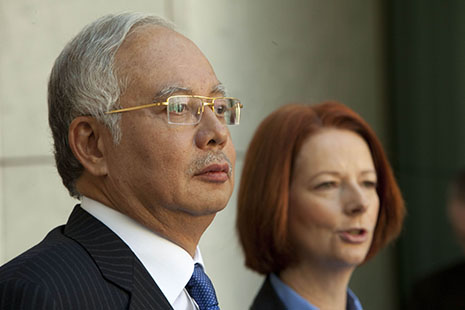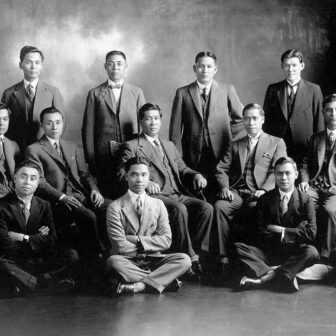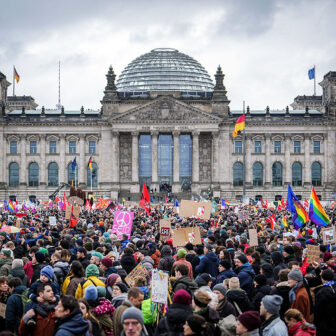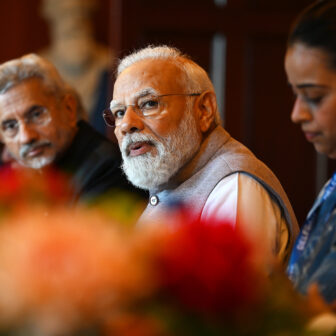THE federal government’s “Malaysian solution” raises a host of as yet unanswered questions. Under the agreement announced on Saturday by Julia Gillard and her Malaysian counterpart, Najib Razak, Australia will resettle 4000 refugees living in Malaysia, and Malaysia will take in 800 asylum seekers intercepted by the Australian navy. The Australian government hailed the agreement as “a landmark new measure as part of a Regional Cooperation Framework that will help put people smugglers out of business and prevent asylum seekers making the dangerous journey to Australia by boat.” That’s where the questions begin.
First, there’s the queue. Where exactly is the orderly process that asylum seekers transferred from Australia to Malaysia are meant to join? Hadn’t the Labor government been dismissive of the idea of sending asylum seekers “to the back of the queue” when it was suggested by Steve Fielding last year? (Australians would like asylum seekers to be told, “If you’re going to try and jump the queue you go to the back of the queue and wait in a refugee camp and wait your turn to come to Australia,” Senator Fielding said in March 2010, in what reads like the blueprint for Saturday’s announcement.)
Then there’s the duration of the commitment. According to the joint statement by Prime Ministers Gillard and Najib, the arrangement is a “one off pilot project.” Last year alone, 6502 “irregular maritime arrivals” sought asylum in Australia. If anywhere near that number arrives once the agreement commences, what will happen once Malaysia has taken the first batch of 800 asylum seekers? Would it be prepared to take another 800, thereby committing Australia to take another 4000 refugees stranded in Malaysia? Or does the Australian government envisage that other countries in the region would also want to swap refugees for asylum seekers at a rate of five to one?
The government is clearly hoping that it won’t be necessary to make arrangements beyond the pilot project because asylum seekers will no longer target Australia for fear that they will be sent to Malaysia. In my view, such hopes would be ill-founded for two reasons. First, it is likely that asylum seekers will again try to reach the Australian mainland rather than Christmas Island or Ashmore Reef (as they did after 2001) – and some will actually make it because, as the tragic events of December 2010 have once again shown, the Australian navy can’t detect all small vessels heading in Australia’s direction. More importantly, many will try (let’s not forget: many of them are desperate because they are fleeing intolerable circumstances) and thus the quota of 800 will soon be filled. Second, the counting starts once the memorandum of understanding between the Australian and Malaysian governments has been signed. In the meantime, possibly hundreds of forced migrants holed up in Indonesia will want to be among the last lucky ones to make it to Australia before the deadline. Many of them won’t make it in time, which again means that the quota could be filled much earlier than the Australian government anticipates.
What happens if asylum seekers processed in Malaysia are recognised as refugees under the criteria of the 1951 Refugee Convention: could they be included in a future batch of 4000 refugees transferred to Australia? Not only might they take their chances, given that there is no orderly queue (in Malaysia, or anywhere else, for that matter). And if other resettlement options are hard to come by – as happened under the Howard government’s Pacific Solution – would Australia guarantee the eventual resettlement of those transferred to Malaysia? Unless Malaysia – contrary to its long-standing practice – was suddenly prepared to resettle asylum seekers recognised as refugees, it would probably insist on such a guarantee.
And finally, and most importantly, there are the conditions in Malaysia. For the plan to work for the two governments, asylum seekers will need to be dissuaded from seeking temporary refuge in Malaysia in the expectation that this will be a pathway to resettlement in Australia if one-in-six of them set out for Christmas Island or Ashmore Reef. A temporary stay in Malaysia may indeed prove to be sufficiently unattractive to persuade refugees fleeing Iraq, Iran and Afghanistan to head for Europe rather than Southeast Asia and Australia – and that’s the very reason why the Malaysian Solution could work and why, at the same time, it is far more insidious than the “solution” proffered by the previous government.
The Sunday Age’s political editor, Michelle Grattan, suggested that “one increasingly needs a microscope to spot the differences between John Howard’s Pacific Solution and the Gillard government’s approach.” Neither Nauru nor Malaysia are signatories to the 1951 Refugee Convention and are therefore not bound by international law not to return refugees to danger. Their laws do not provide for the granting of asylum or refugee status, and their governments have not established a system for providing protection to refugees. But that’s where the similarities end.
The differences aren’t as difficult to spot as Michelle Grattan claims. Unlike Nauru, Malaysia hosts a sizeable number of forced migrants – more than 170,000 according to the latest (2009) estimate by the US Committee for Refugees and Immigrants. The asylum seekers who were sent to Nauru by the Howard government had good reason to complain bitterly about their isolation and living conditions, which were well documented, not least in Michael Gordon’s book Freeing Ali. But neither the government of Nauru nor individual Nauruans were responsible for their predicament. In fact, the latter were welcoming rather than hostile.
The Malaysian solution could act as a more effective deterrent than either temporary protection visas or the prospect of being stranded on Nauru ever did, because refugees are not welcome in Malaysia. In Malaysia, forced migrants are frequently and arbitrarily arrested, detained and deported.
Malaysian law does not distinguish between refugees, asylum seekers and other irregular migrants. According to a recent Amnesty International report, “all are considered to be illegal and are subject to the same penalties.” Those penalties include fines, imprisonment and caning. Between 2002 and 2009, according to official statistics, 47,914 migrants were caned for immigration offences. Children are exempt from being caned – provided they are under the age of ten. But the reference to children is not to suggest that caning is a rather mild – or even purely symbolic – form of punishment.
Amnesty International has branded caning a form of torture. In a recent report, the organisation provides a graphic indictment: “Across Malaysia, government officials regularly tear into the flesh of prisoners with rattan canes (rotan) travelling up to 160 kilometres an hour. The cane shreds the victim’s naked skin, turns the fatty tissue into pulp, and leaves permanent scars that extend all the way to muscle fibres. Blood and flesh splash off the victim’s body, often accompanied by urine and faeces… The pain inflicted by caning is so severe that victims often lose consciousness as a result. Afterwards the suffering can last for weeks or even years, both in terms of physical disabilities and psychological trauma.”
Some refugees are subject to deportation – or worse. According to a US State Department report, “in previous years there were many allegations from NGOs, international organizations, and civil society groups that immigration officials were involved in the trafficking of Burmese refugees from [immigration detention centres] to Thailand, where some refugees were sold into slavery.” The prices charged by those officials reportedly range from US$250 to US$500 per deported refugee. While there were no reports of similar incidents last year, the State Department concluded in another report, less than a year ago, that the government of Malaysia still “does not fully comply with the minimum standards for the elimination of trafficking.” Trafficking is an ongoing problem in the country, said the report, and some trafficking victims are “locked up in warehouses or brothels.”
Police and immigration officials aren’t the only ones refugees have reason to fear. Members of the two-million-strong People’s Volunteer Corps, a militia whose members receive little training, have been accused of raping, beating and stealing from irregular migrants, including those who have been issued with a card by the UNHCR to certify that they have been recognised as refugees in need of protection.
Malaysia’s sixteen immigration detention centres are already overcrowded. According to credible reports by NGOs, inmates lack regular access to clean drinking water, appropriate medical care and proper sanitation. A Malaysian Human Rights Commission report published in 2008 found that 1300 people had died in detention centres and prisons over a six-year period – largely as a result of poor medical care.
Yet, having said all that, the agreement reached on Saturday could also end up being a bold move in the right direction. Gillard and Najib agreed that asylum seekers transferred from Australia to Malaysia “will be treated with dignity and respect and in accordance with human rights standards.” It seems inconceivable that Malaysia will exempt those 800 people (and then, perhaps, another 800, and another 800…) from being caned, arbitrarily arrested, detained in overcrowded immigration detention centres and deported whence they came. After all, a card issued by the UNHCR has done little to protect refugees, so why would a letter saying its bearer needs to be “treated with dignity” on the grounds that he or she once nearly made it to Australia be any different?
Given that Australia has committed to funding the arrangement, however, the Najib government could demand that Australia help it treat all other refugees and asylum seekers currently living in Malaysia “in accordance with human rights standards.” Australia would then, commensurate with its economic capabilities and regional leadership aspirations, be able to initiate a genuine regional solution for forced migrants in the Asia-Pacific. It would facilitate the integration of forced migrants in Malaysian society by providing money for additional teachers and doctors. It would fund a well-trained police force whose only purpose is to uphold the law, and allow Malaysia to disband the People’s Volunteer Corps. The Malaysian government would accede to the 1951 Refugee Convention, introduce changes to its Immigration Act to distinguish clearly between refugees, asylum seekers, trafficking victims and other undocumented migrants, and provide protection to those recognised as refugees.
Together, Malaysia and Australia could create a model that could be exported to other countries in the region that host large numbers of forced migrants: Thailand or Pakistan, for example. In fact, they would need to export that model in case people smugglers directed Afghans and Iraqis and Burmese to Malaysia rather than to Australia. Julia Gillard might have had such a solution in mind when she persuaded her Malaysian counterpart to agree to the “pilot project.” And pigs might fly. (Actually, when it comes to this intractable public policy issue, they have to.) •




